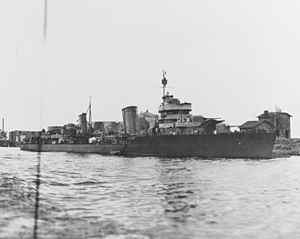 Unknown Leningrad-class destroyer in Leningrad, June 1944
| |
| History | |
|---|---|
| Name | Tbilisi |
| Namesake | Tbilisi |
| Ordered | 2nd Five-Year Plan |
| Builder | Shipyard No. 199, Komsomolsk-on-Amur |
| Laid down | 15 January 1935 as Tiflis |
| Launched | 24 July 1939 |
| Commissioned | 11 December 1940 |
| Renamed | Tbilisi, 24 July 1939 |
| Reclassified | As target ship, 18 April 1958 |
| Stricken | 31 January 1964 |
| Fate | Scrapped, 1964 |
| General characteristics (as built) | |
| Class and type | Leningrad-class destroyer leader |
| Displacement | 2,350 long tons (2,390 t) (standard) |
| Length | 127.5 m (418 ft 4 in) (o/a) |
| Beam | 11.7 m (38 ft 5 in) |
| Draft | 4.06 m (13 ft 4 in) |
| Installed power |
|
| Propulsion | 3 shafts; 3 geared steam turbines |
| Speed | 40 knots (74 km/h; 46 mph) |
| Range | 2,100 nmi (3,900 km; 2,400 mi) at 20 knots (37 km/h; 23 mph) |
| Complement | 250 (311 wartime) |
| Sensors and processing systems | Arktur hydrophones |
| Armament |
|
Tbilisi (Russian: Тбилиси) was one of six Leningrad-class destroyer leaders built for the Soviet Navy during the 1930s, one of the three Project 38 variants. Completed in 1940, the ship was assigned to the Pacific Fleet, with which she spent World War II. Tbilisi laid minefields outside Vladivostok early in the war and during the Soviet–Japanese War transported naval infantry in preparation for an amphibious landing in Korea. Postwar, she continued to serve with the Pacific Fleet and began a lengthy overhaul in 1951 that lasted until 1955. Converted into a target ship in 1958, she was finally struck from the Navy List in 1964 and scrapped.